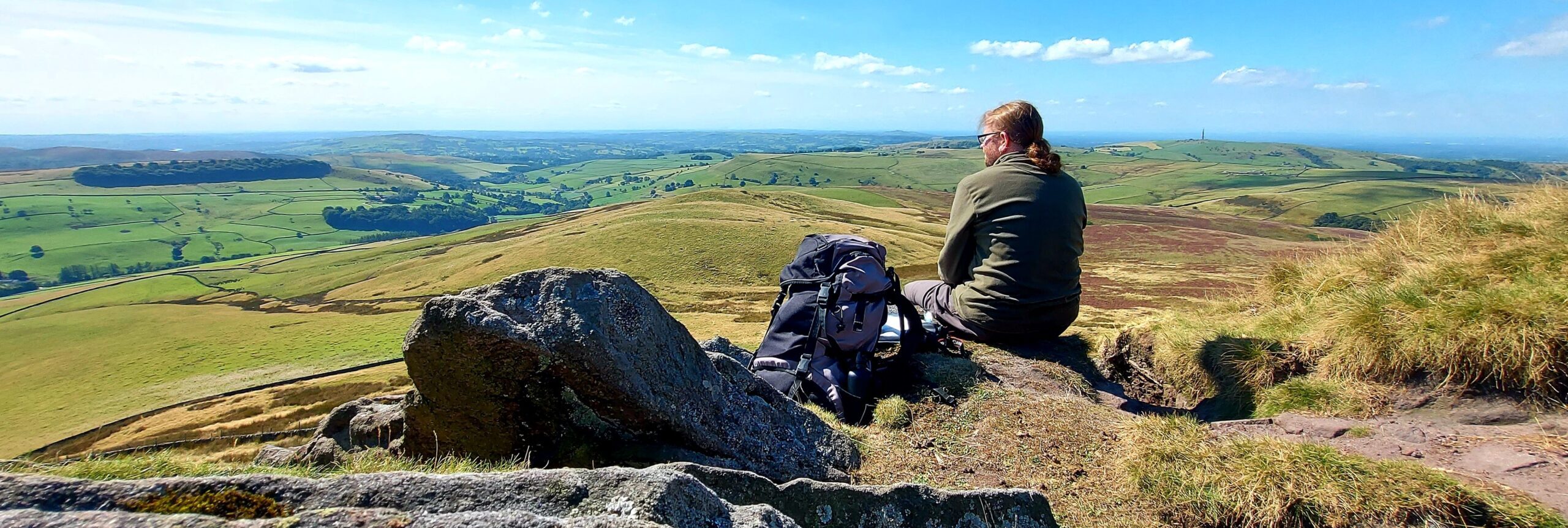Approximate Location
OS Grid Reference: SJ 861 776
Latitude: 53.29.54N Longitude: 2.20.81W
A well-known and popular landmark on Alderley Edge, Goldenstone lies on the south-east of the hill and is an ancient boundary marker. It appears several times in the Weirdstone Trilogy. Initially, it is noted as being a waypoint on the journey of the farmer and the wizard from Thieves Hole to the cave of the sleepers in The Legend of Alderley:
“By Seven Firs and Goldenstone they went, to Stormy Point and Saddlebole.“
Garner, A., 1960 (1989 edition), The Weirdstone of Brisingamen. William Collins / Lions. London. p10.
It was described in Weirdstone, Chapter 15: A Stromkarl Sings at a point after the children and dwarves escaped the Earldelving and were warned not to try and access Fundindelve as the morthbrood were watching the entrances:
“They came to a junction in the path, and to their right stood a boulder, with nothing golden about it that the children could see : it was like any outcrop of weathered grey sandstone, except that it had been crudely worked to an oblong shape by men long dead, and few can now tell its purpose.”
Garner, A., 1960 (1989 edition), The Weirdstone of Brisingamen. William Collins / Lions. London. p144.
Goldenstone clearly held great significance in the magical world, especially for the elves – although Albanac thought that it even pre-dated those folk (Gomrath, Chapter 8: Shining Tor). Atlendor and Durathror specifically chose it as the place where they said their farewells (Weirdstone, Chapter 16: The Wood of Radnor). The rock was a waymarker on the old straight track that Colin followed from the Beacon in Gomrath, Chapter 8: Shining Tor.
Memorably, the Morrigan hurled a hex at Uthecar and Susan which cleaved the Goldenstone in two (Gomrath, Chapter 14: The Wild Hunt) in frustration at the waning of her moon magic at dawn and the fact that she could not assail the fugitives directly as they were using the elf road.

I find the last story very satisfying as it seems to be Alan Garner‘s version of an origin myth for the appearance of Goldenstone. The site played an important part in the evolution of the author’s interest in the folklore and archaeology of Alderley Edge. In 1955, aged just 19, Garner was so intrigued by the place-name in The Legend of Alderley that he set out to find what was then a lost landmark. After tracking down the location, using the 1598 Court Leet of Nether Alderley, he actually excavated Goldenstone from within an embankment that had been formed along the elf road (The Voice That Thunders 1997, 65-79). Garner has revealed that during his excavation he “unearthed a high-explosive three-seven Heavy Ack-Ack twenty-five pounder shell with a mechanical two-zero-eight Mark six-two fuse; and it was armed” that had been dropped by the Luftwaffe during the Second World War (Where Shall We Run To? 2018, 181-86). He also found a polished stone prehistoric axe beneath Goldenstone which he later used as a powerful motif in his 1973 novel Red Shift (The Voice That Thunders 1997, 79).
In The Voice That Thunders (1997, 65-79), Garner considers Goldenstone in an essay entitled Oral History and Applied Archaeology in East Cheshire. He concluded that it was part of a system of astronomical landmarks which also included Shining Tor, the Armada Beacon and a mound in Mobberley churchyard that were connected to prehistoric astronomical observations. I’m not eternally certain that his argument would stand up to rigorous archaeological criticism, but the article does contain many useful observations about prehistoric sites across the Edge and beyond.
The stone became a scheduled monument in 2001.

